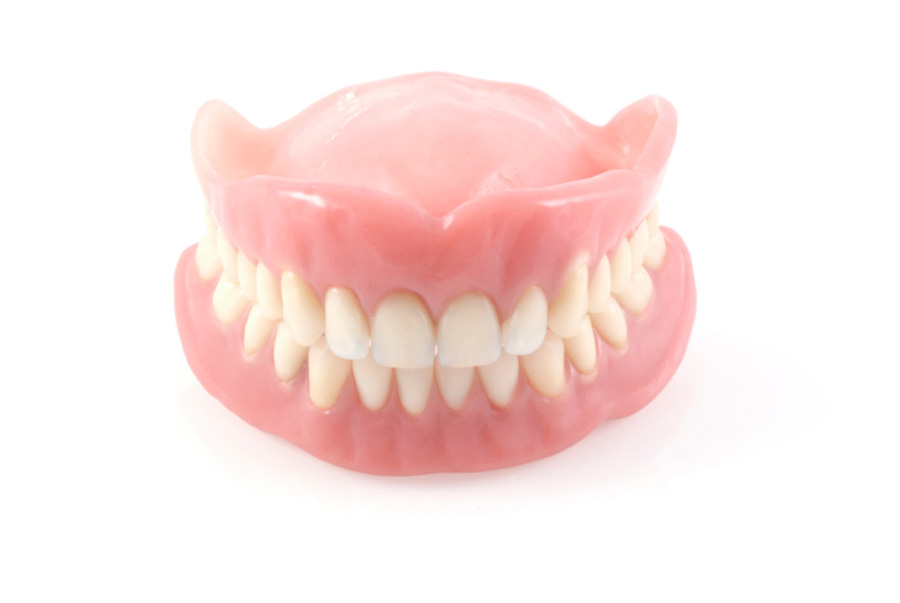Complete dentures

Complete prosthesis
Complete prosthesis, also known as a denture:
- It is used to replace all the teeth (14 in all, excluding wisdom teeth) in a dental arch (upper or lower jaw).
- It covers and rests on a large part of the gum. The complete upper jaw prosthesis also covers and rests on the palate.
- It is held in place in the mouth by the suction effect created by the saliva that accumulates between the prosthesis and the gum. In the lower jaw, it holds in place mechanically, i.e. according to the shape of the gingiva.
Prosthesis categories
Artificial teeth for a prosthesis are fitted using an articulator, a mechanical device that supports models of the upper and lower jaws and simulates mouth movements. Depending on the type of articulator used by the denturist, prostheses can be classified into different categories.
Here are two available at our clinic:

Semi-precision prosthesis
To determine the position of the teeth in this type of prosthesis, the articulator used reproduces protrusion (forward movement of the chin) and laterality (movement of the chin to the right and left). This method ensures excellent prosthetic stability and perfect mastication on both sides of the jaw.
Centric prosthesis (standard)
With a centric prosthesis, the artificial teeth are fitted using an articulator called an occluder. This device reproduces the opening and closing movement of the mouth, but does not simulate chin movements to the sides or forwards.
Tooth position adjustment is performed on a non-adjustable appliance and is based on physiological averages for the general population. These prostheses therefore lack the superior fit and function of precision and semi-precision prostheses, but have the advantage of being economical. What’s more, this type of prosthesis is ideally suited to the recently edentulous patient, as there is still sufficient gum tissue to ensure good denture stability.
Soft base
Over the years, the jawbone resorbs, especially that of the lower arch. The prosthesis thus becomes less and less stable, and can injure the gums or cause discomfort.
If an implant-supported prosthesis is not an option, a soft base may be a good compromise. This technique involves the permanent application of a cushion (silicone layer) inside the prosthesis. The soft base has a porous surface, so it adheres well to the gums and improves the comfort and stability of the prosthesis.
This solution still requires periodic adjustments, as it will not prevent the underlying bone from changing and atrophying over time. The soft base should be changed after 2 to 3 years of use.
What’s more, prostheses with a soft base are harder to clean and require rigorous maintenance.
Metal vault
The metal arch is made of cobalt chrome and shaped to follow the curves of the palate, resulting in a comfortable, well-fitting prosthesis that stays securely in place in the mouth. This is done in a specialized laboratory.
Advantages :
- Stronger and more resistant than dentures made entirely of acrylic (recommended, for example, for patients who suffer from bruxism, who have a full denture resting against an arch of natural teeth, and patients with poor dexterity who risk dropping the denture when handling it);
- Slimmer, so more comfortable and easier to speak;
- Does not change dimension over time;
- Better thermal conductivity, so patients can feel temperature differences.
Disadvantages :
- This type of prosthesis does not allow relining in areas where the metal is in contact with mucous membranes;
- Higher cost than acrylic prosthesis;
- Suction may be less pronounced in dentures with a metal arch than in acrylic full dentures;
- The metal frame may be visible and detract from the aesthetics.
Porcelain or acrylic teeth?
Here’s why:
- Porcelain teeth are harder than natural teeth, so they tend to prematurely wear down the natural teeth with which they come into contact (e.g. a full denture in the upper jaw that closes against natural teeth in the lower arch).
- Even in the absence of natural teeth, the contact of two complete dentures with porcelain teeth emits vibrations that can be damaging to the gums and jawbone.
- Porcelain teeth are less well bonded to the rest of the prosthesis than acrylic teeth. Over the years, saliva tends to penetrate between the porcelain tooth and the acrylic part supporting it, forming a black ring that’s impossible to clean. What’s more, porcelain teeth eventually become brittle and detach from the acrylic part.
- Porcelain teeth are more fragile and brittle than acrylic teeth.
Acrylic teeth are therefore a better choice for preserving remaining teeth and avoiding early gum resorption. They are resistant to breakage, resemble natural teeth and can be repolished to remove stains and restore a glossy finish.

Immediate full prosthesis
This prosthesis is inserted on the same day, immediately after the teeth to be replaced have been extracted, thus avoiding the need to go out in public with missing teeth. The immediate prosthesis is made from the impression of the original teeth, before they are extracted.
Advantages :
- Since this prosthesis is designed while your natural teeth are still in your mouth, their shape, color and arrangement are easier to reproduce;
- Inserted immediately after extraction, it acts as a dressing, protecting tissues and limiting bleeding;
- Adapting to speaking with a prosthesis will be easier if you wear an immediate prosthesis than if you spend some time without teeth and prosthesis while waiting for a definitive prosthesis;
- The prosthesis also ensures that you don’t lose your ability to chew, and minimizes the facial distortion that can occur when teeth are removed;
Disadvantages :
- The immediate prosthesis will require several adjustments (several visits to the denturist for temporary relines);
- Once the soft tissue has healed and the underlying bone has shrunk (3 to 6 months after extractions), the immediate prosthesis must be permanently relined or a new prosthesis fabricated.
Note: If you have a new prosthesis made after the healing period, you can keep the immediate prosthesis as a spare, which is very practical in the event of breakage, loss or repair of your main prosthesis.
What are the advantages of immediate dentures?
- better protection of oral tissues;
- reduced bleeding;
- uniform healing of the gums;
- helps with pronunciation and chewing.
Disadvantages of immediate prostheses
As the gums heal, the prosthesis may become too large and unstable. The denturist must then be called in for a temporary reline, sometimes more than once. After 3 to 6 months, permanent relining will be necessary. Don’t neglect these periodic adjustments to the immediate prosthesis, as they may result in damage to the oral tissues and the need for surgery in some cases.
Who can benefit from dental prostheses?
- A person of any age who has suffered partial or total loss of dentition due to several reasons, such as accident, disease, congenital condition, age or poor oral hygiene.
- A person with a significant health problem, especially cardiac patients, for whom surgery may be contraindicated.
- Patients with insufficient jawbone support to consider other available treatment plans.

Available base types
2 basic types are available:
- Pink (acrylic) resin: Color mimics natural gingiva. Full dentures are almost exclusively made of acrylic; they are sometimes reinforced with other types of material, such as fiberglass or a metal alloy.
- Metal alloy: The metal structure is very thin and lighter than the acrylic base, but stronger, so it often acts as a reinforcement for the acrylic base.
Artificial teeth
The artificial teeth fitted to the base of the prosthesis are made of tooth-colored resin (acrylic) or porcelain (ceramic ) (less commonly used today).
What are the expected results?
For those of you who have lost one, several or all of your teeth, a removable prosthesis can improve your quality of life in the following ways:
- Restore normal masticatory function.
- In the case of a partial denture, reduce the weight of masticatory forces on structures still present in the mouth.
- In the case of a partial denture, ensure the stability of the remaining healthy teeth by avoiding their displacement into the edentulous spaces.
- Filling the lack of support caused by the missing tooth or teeth.
- Promote phonetic speech for sounds requiring the tongue to press against the teeth.
-
How much do dentures cost?
- Consult your denturist for the cost of a removable prosthesis.
- A removable prosthesis is still less expensive than treatment plans involving dental implants.
- Some dental insurance companies reimburse part or all of the cost of a removable prosthesis.

Steps and timetable for denture fitting
Depending on how the prosthesis is fabricated (on site at the clinic, in an external laboratory, etc.), it may take from a few days to a few weeks to complete the following steps:
- Denturological examination and impression of your mouth to obtain details on the shape of the gums and the position of structures inside the mouth or adjacent to the future prosthesis, such as the tongue, lips and cheeks.
- Measure jaw position and choose teeth (color, shape and material) and base material according to the complete physiognomy of your mouth and your preferences.
- Prosthetic fabrication in the laboratory (on site at the clinic). The prosthesis is manufactured without an intermediary, except in the case of metal partial dentures, where the metal structure is fabricated by an external laboratory.
- Fitting of the prosthesis, during the fabrication period, to verify its function and aesthetics with your physiognomy, as well as preliminary adjustments. Several fittings may be required for a complete prosthesis.
- The final prosthesis is placed in the mouth, along with any adjustments and corrections required to optimize your comfort.
If you’ve had dental extractions, a denture adjustment 3 to 6 months after the extractions is recommended following the gingival loss experienced during healing of the extraction sites.
The advantages of dentures
- The manufacture of a removable prosthesis is less expensive than alternative treatments (e.g. dental implants).
- The manufacturing period is much shorter than the time required to complete certain other alternative treatments (e.g. dental implants).
- The removable prosthesis is a non-invasive treatment plan, since no surgical procedures are required, except if tooth extractions are necessary.
- An alternative, more permanent treatment plan may be considered in the future, should you decide to stop wearing your removable prosthesis, and if your medical condition permits. In other words, wearing a removable prosthesis is “reversible” under certain conditions.
- Your smile (final result) after the prosthesis has been placed in your mouth can be predicted by the color and shape given to the prosthesis teeth, so that they blend in completely with your remaining dentition (partial prosthesis) or your old dentition (complete prosthesis).
- You can remove it and replace it later.
- It can be readjusted as needed to ensure it’s always comfortable.
The disadvantages of dentures
- Food may become lodged under the prosthesis, causing discomfort; you must then remove it to dislodge the debris.
- Partial denture clasps are susceptible to plaque and tartar build-up. So it’s important to maintain good dental hygiene, and to continue visiting the dentist regularly.
- The clasps of a partial denture can sometimes be visible, negatively affecting the aesthetics of the denture in the mouth.
- Lower jaw prostheses may be less stable than upper jaw prostheses. This instability is caused by the smaller shape of the gingiva, tongue movements and insufficient saliva, which hampers the suction effect needed to hold the prosthesis in place.
- You’ll need to allow for an adaptation period of varying length, which can average a month or more when you wear a removable prosthesis (full or partial) for the first time. During this period, changes in the way you eat and speak are necessary. Your taste may also be slightly altered when dentures are worn on the upper jaw, because the palate is covered by the prosthesis.
- Gum injuries can occur if the prosthesis is not properly fitted, or if changes to the gum or jaw occur over time, such as sagging.
- This is because a removable prosthesis does not stress the alveolar bone, the bone that supports the teeth and shapes the gums, so the gums tend to resorb (disappear).
- A reline (reshaping of the base) of the prosthesis may then be necessary to restore the stability and comfort of your prosthesis, while ensuring that the alveolar bone does not lose too much volume.
- It can be difficult to play a wind instrument with a removable prosthesis.
- The lifespan of a removable prosthesis is around 5 years, sometimes a little more, but rarely more than a decade. This entails additional costs for replacing damaged teeth, making adjustments to the prosthesis, relining the prosthesis or replacing it altogether when it is too worn.
- There are signs that the denture may need to be replaced or repaired, which is why it’s important to have it checked regularly by your dental professional.
Undesirable health consequences can occur with dentures that are too old, such as irritated gums that hurt, digestive problems caused by more difficult chewing, aches and pains of all kinds in the head, neck, ears and even jaw joint problems, premature aging of your face, and so on.
